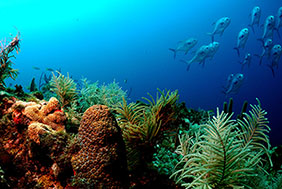-
Home
-
Data & Publications
-
Regional Portals
- About Regional Portals
- Florida
- Navassa Island
- Puerto Rico
- Flower Garden Banks
- U.S. Virgin Islands
- American Samoa
- Commonwealth of the Northern Mariana Islands
- Federated States of Micronesia
- Guam
- Main Hawaiian Islands
- Republic of the Marshall Islands
- Northwestern Hawaiian Islands
- Republic of Palau
- Pacific Remote Island Areas
-
CRCP Activities
- Glossary
NOAA Strategy for Stony Coral Tissue Loss Disease Response and Prevention
the diseased coral next to it will likely suffer the same fate in Looe Key.
Photo credit: Greg McFall/NOAA
Stony coral tissue loss disease was first observed in south Florida in 2014. As of September 2020, it has spread to 13 Caribbean countries and territories. The outbreak is unique due to its large geographic range, extended duration, rapid progression, high rates of coral mortality, and the number of species affected. Once infected, coral colonies typically die within weeks to months. While the cause of the disease is still unknown, it is believed that the pathogen may have a bacterial component due to its response to antibiotic treatments. Stony Coral Tissue Loss Disease can be transmitted to other corals through direct contact and water circulation. Recently, leadership from Indo-Pacific countries and territories shared concerns that the disease could spread into the region.
NOAA is working with state and federal partners in Florida, the U.S. Virgin Islands, and Puerto Rico to lead disease response efforts in these coral reef jurisdictions, and is specifically supporting coordination with the wider Caribbean region.
The NOAA Strategy for Stony Coral Tissue Loss Disease Response and Prevention provides a framework and focus for ongoing efforts to slow the spread of the disease across the Atlantic and Caribbean regions and to prevent and prepare for the possible spread of the disease into the Indo-Pacific region in support of resilient coastal ecosystems, communities, and economies nationwide. The strategy will build on ongoing efforts to understand, respond to, and mitigate the disease and be used to inform a national-level implementation plan.
Download the executive summary: NOAA Strategy for Stony Coral Tissue Loss Disease Response and Prevention - Executive Summary
Download the strategy: NOAA Strategy for Stony Coral Tissue Loss Disease Response and Prevention
Related Resources
- Stony Coral Tissue Loss Disease: Surveillance Guidelines for the Indo-Pacific
These guidelines are for coral reef managers and field conservation practitioners and researchers in the Indo-Pacific region regarding surveillance and detection of stony coral tissue loss disease (SCTLD).
For more information contact:
Dana Wusinich-Mendez at dana.wusinich-mendez@noaa.gov


